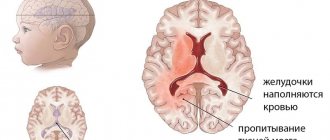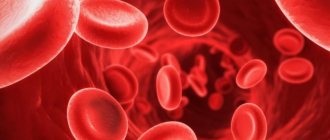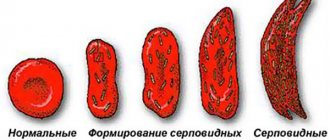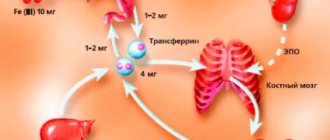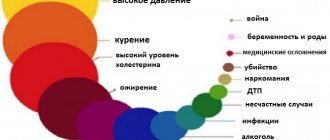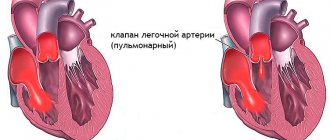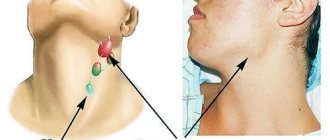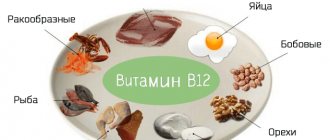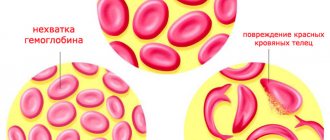What is hemoglobin and its normal values
Hemoglobin is an element that makes up red blood cells - it is what gives these blood cells their bright red hue.
This element provides the body's cells with oxygen, delivering it from the lungs directly to the systems and internal organs. In order for hemoglobin to quickly form in the human body, the following conditions must be met:
- Availability of the required amount of iron in the diet.
- Complete absorption of this substance in the stomach and intestines.
- The presence of animal proteins in food.
- Absence of pathological processes in the circulatory system.
- The presence in the body of folic acid and some types of vitamins, which are necessary for the synthesis of red blood cells, which takes place in the bone marrow. If there is a sharp decrease in the level of red blood cells, a decrease in hemoglobin also occurs (it has long been proven that these elements are interconnected).
With low hemoglobin levels, a variety of serious diseases occur in humans. Important: approximately 90% of them are due to iron deficiency anemia.
To find out what the danger of this condition is, you should take a closer look at the stages of anemia:
- mild – a person’s iron level is -g/l;
- average – 70-90%;
- severe – indicators less than 70%.
Symptoms and treatment of mild anemia
Typically, a mild degree of the disease is asymptomatic and is determined only based on the results of a laboratory blood test.
Anemia. Degree of severity based on hemoglobin level. Treatment at home is presented in our article
Sometimes the following symptoms appear:
- Deterioration in concentration;
- Rapid pulse;
- Decreased performance;
- Memory problems;
- Weakness, fatigue and fatigue;
- Paleness of the skin and mucous membranes.
Each specific case of anemia has its own causes, which only a doctor can identify. For diagnosis, laboratory blood tests are prescribed. The most common is iron deficiency anemia, i.e. a decrease in hemoglobin concentration causes a lack of iron in the body.
Treatment of mild anemia often comes down to choosing the right diet in order to normalize the level of hemoglobin in the blood. A restorative diet includes foods high in iron and B vitamins.
Don't miss useful advice from doctors about: Sinusitis: symptoms and treatment at home
These include: red meat, liver, fish, eggs, nuts, spinach, beets, apples, pomegranate, carrots, tomatoes, greens, beans, buckwheat and oatmeal, bread, honey, etc.
It is important to know! At the first signs of even mild anemia, you should immediately consult a doctor to quickly determine the reasons that caused it. Self-medication in this case is unacceptable.
Why do heart murmurs occur?
Low hemoglobin can often be explained by known blood loss, such as from menstruation, or it may be the first signal that hidden bleeding may be occurring somewhere in the body.
The gastrointestinal tract is often one of the most common sites of hidden bleeding and can be caused by hemorrhoids, polyps, colon cancer, or other diseases.
Depending on your age and medical history, low hemoglobin levels may indicate the need for a colorectal cancer screening test, such as a colonoscopy.
In people with established colorectal cancer, anemia can be caused by a number of different factors, including the cancer itself and treatments such as radiation and chemotherapy (a group of chemotherapy drugs known as platinum-based chemotherapy is particularly fraught with complications).
Hemoglobin (HB) is often talked about without even knowing, but only suspecting its importance in the human body. Anemia, popularly called anemia, or too thick blood, is usually associated with variations in the values of the red blood pigment. Meanwhile, the range of tasks of hemoglobin is very wide and its fluctuations in one direction or another can cause serious health problems.
The hemoglobin molecule is a complex protein (chromoprotein) consisting of four hemes and the globin protein. Heme, which has divalent iron (Fe2) at its center, is responsible for binding oxygen in the lungs. Combining with oxygen and turning into oxyhemoglobin (HHbO2), it immediately delivers the component necessary for respiration to the tissues, and from there it takes carbon dioxide, forming carbohemoglobin (HHbCO2), to transport it to the lungs. Oxyhemoglobin and carbohemoglobin are physiological hemoglobin compounds.
The functional responsibilities of the red blood pigment in the human body also include participation in the regulation of acid-base balance, because it is one of four buffer systems that maintain a constant pH of the internal environment at the level of 7.36 - 7.4.
In addition, being localized inside red blood cells, hemoglobin regulates blood viscosity, prevents the release of water from tissues and, thereby, reduces oncotic pressure, and also prevents unauthorized consumption of hemoglobin when blood passes through the kidneys.
Hemoglobin is synthesized in erythrocytes, or rather, in the bone marrow, when they are still in the nuclear stage (erythroblasts and normoblasts).
Even better than with oxygen, hemoglobin binds with carbon monoxide (CO), transforming into carboxyhemoglobin (HHbCO), which is a very strong compound that significantly reduces the physiological abilities of red blood pigment. Everyone knows how dangerous it is for a person to stay in a room filled with carbon monoxide.
It is enough to inhale only 0.1% CO with the air so that 80% of Hb combines with it and creates a strong bond, leading to the death of the body. It should be noted that smokers are constantly at risk in this regard; in their blood, the content of carboxyhemoglobin is 3 times higher than normal (N - up to 1%), and after a deep puff it is 10 times higher.
A very dangerous condition for the hemoglobin molecule is the replacement of divalent iron in heme (Fe2) with trivalent iron (Fe3) with the formation of a form dangerous to health - methemoglobin. Methemoglobin sharply inhibits the transfer of oxygen to organs, creating conditions unacceptable for normal life.
Methemoglobinemia occurs as a result of poisoning with certain chemicals or is present as a hereditary pathology. It may be associated with the transmission of a defective dominant gene or due to recessive inheritance of a special form of enzymopathy (low activity of an enzyme capable of restoring metHb to normal hemoglobin).
Heart murmurs can be a normal physiological phenomenon or a pathology of the cardiovascular system. There are a number of factors that will help determine the severity of this symptom. In order to monitor the condition of the heart and promptly detect any abnormalities in its functioning, it is necessary to periodically visit a cardiologist.
A heart murmur is the acoustic effect of changes in cardiac and vascular blood flow. Most doctors attribute the appearance of murmurs to a disease that requires immediate treatment. The nature of noise formation can be different:
- organic;
- inorganic.
Organic noises indicate that some pathologies have arisen during the development of the cardiovascular system. Most often, they begin to appear at birth, but such a developmental defect does not always indicate a serious illness. Quite often it happens that organic murmurs in the heart indicate only deviations in the formation of the system that are not harmful to health. Over time, the problem disappears on its own.
Inorganic ones arise as a result of previous diseases or heart pathologies. The causes of noise are varied. One of the most common is morphological, when disorders occur in the heart valves. Rheological and anatomical reasons are no less serious.
The patient will not be able to detect malfunctions of the heart on his own; the presence of murmurs can only be determined through examination. A specialist can identify heart murmurs by the following symptoms:
- anemia, pale skin, general weakness in the body;
- trembling in the arms and legs, excessive temper, irritability, sudden weight loss;
- increased swelling of the legs, tachycardia, shortness of breath at rest and after exercise;
- the patient feels his heartbeat after physical activity;
- excessive fatigue, sudden mood swings and frequent dizziness.
If a heart murmur indicates the presence of any concomitant disease, more severe symptoms may appear in the form of constant shortness of breath at low loads and at rest. Swelling, pain in the chest, loss of consciousness, and attacks of suffocation occur. Only a cardiologist can determine the nature of the symptoms and their severity.
If the murmurs are of organic origin, and the patient has known their presence since birth, then he will constantly visit the cardiologist without worsening his condition. If previously there were no problems with the functioning of the cardiovascular system, but signs of the disease began to appear, you should visit a therapist.
Typically, the GP will not be able to determine the severity of the situation, so they will provide a referral to see another specialist. An experienced cardiologist is able to determine the presence and cause of murmurs at the first examination, but he will be able to make a final diagnosis and prescribe treatment only on the basis of the results of tests and studies.
The very first and one of the most effective research methods is auscultation. The doctor uses a stethoscope to listen to the chest for sounds. If noise has been detected, then by its nature the cause of its occurrence can be determined. To clarify the diagnosis, a cardiologist may prescribe an ECG and ECHO.
FCG is a diagnostic method that allows you to record the slightest sound defects in the functioning of the cardiovascular system. During the examination, several tests are required. The first of them is a general blood test, on the basis of which the hemoglobin level and leukocyte concentration are determined. Biochemistry is performed to determine the condition of the kidneys and liver.
The final test is a blood test to determine the level of thyroid and adrenal hormones. If rheumatism has previously been diagnosed, or there is a suspicion of its presence, rheumatological tests may be needed. After all the necessary data on the patient’s condition has been collected, the cardiologist selects a therapeutic course to improve the condition or for a complete cure.
Currently, medical diagnostics is at a fairly high level. Monitoring the state of health begins at the intrauterine stage of the child’s development. This has its advantages, since you can find out in a timely manner about the presence of any significant developmental abnormalities or diseases that require immediate intervention.
You can watch the work of the organs on the screen. Today, it is even possible to consult online with specialists from other cities. People, seeing a conclusion with a lot of ornate words and special terms, begin to panic, believing that they are sick with something.
A similar problem concerns young parents. Having barely gotten used to their new role, new fathers and mothers take responsibility for the health of their baby. Having heard about the presence of a murmur in their child’s heart, they are very worried, imagining their child as seriously ill. It is necessary to distinguish between heart murmurs in an adult and a child.
Almost all newborn children experience this phenomenon. Noises indicate a functional process of restructuring the cardiovascular system. After birth, the neonatologist listens to the baby’s chest; in the maternity hospital, the baby undergoes an abdominal ultrasound, carefully examining the heart. All these measures are necessary to exclude the possibility of the child developing heart disease.
Treatment
Only a doctor can prescribe adequate therapy. Symptomatic treatment is predominantly carried out. If the noise is caused by anemia, then a course of taking medications containing iron is prescribed. For better absorption, medications are taken in combination with ascorbic acid. Soon the hemoglobin level will increase, which will reduce or completely eliminate heart failure.
Why is anemia dangerous?
Without the necessary treatment, the consequences of anemia can be so serious that it may be impossible to correct them. When hemoglobin levels are low, the body's defenses are weakened. As a result, infections, viruses and other pathogenic microorganisms can easily cause various health problems.
With anemia, the cardiovascular system wears out, which over time leads to heart failure.
Important! With anemia, not only the physical condition of the patient worsens, but also his psycho-emotional state. He becomes distracted, irritable and has memory problems.
Anemia can lead to the following complications:
- Weak immunity and, as a result, frequent infectious and viral diseases;
- Delayed mental and physical development in childhood;
- Dysfunction of the respiratory and digestive organs;
- Cardiovascular diseases (eg, coronary heart disease, heart failure);
- Decreased vision functions
- Hypoxic coma (often fatal)
The most dangerous is considered to be the 3rd degree of anemia, in which the hemoglobin level drops below 70 g/l. In this state, all organs and systems of the body stop working normally. This can lead to acute kidney failure, cardiogenic shock, blood loss, heart attack and stroke caused by heart failure.
The danger of anemia for women
The female body is more susceptible to anemia, which can lead to various consequences.
- During pregnancy, a lack of hemoglobin increases the risk of miscarriage and developmental delay in the fetus;
- The appearance of skin, hair and nails deteriorates;
- The risk of diseases of the genitourinary system and infertility increases;
- Dental health suffers.
Treatment of low hemoglobin
Any person should know the normal hemoglobin levels: for men, the lower threshold should not fall lower than 130, for women - lower than 120. The doctor prescribes treatment in accordance with hemoglobin levels. It is customary to distinguish three degrees of its reduction:
- mild – when hemoglobin is from 110 to 90 g/l;
- average, when hemoglobin is reduced from 90 to 70 g/l;
- severe when hemoglobin is very low - less than 70. Treatment can be aimed at both restoring basic parameters and restoring balance in the blood serum. In this case, first of all, it is necessary to eliminate the reasons that led to the decrease in hemoglobin.
READ ON TOPIC:
Women who don't get enough sleep are more susceptible to diabetes
At the second stage, you need to ensure that the red blood cells are normal.
Blood transfusion with low hemoglobin is one of the extreme measures. However, she can really help. This procedure is prescribed when the hemoglobin level falls below 60 g/l. With higher hemoglobin, any doctor will insist on a special diet and other medications.
In particularly severe cases, iron injections are also prescribed, but such treatment must be inpatient. There are severe allergic reactions to some drugs, including anaphylactic shock. So only a doctor prescribes medications and their doses. An excessive dose of an iron-containing drug can cause an allergic reaction, and an insufficient dose will not allow you to achieve positive results.
A low hemoglobin level is a sufficient reason to worry about your health
A low hemoglobin level is a sufficient reason to worry about your health. Unfortunately, not knowing the consequences, people do not pay attention to it. Reduced hemoglobin in 90% of cases indicates the presence of iron deficiency anemia and other very serious diseases. That is, hemoglobin should be normal, this needs to be monitored.
mild – when hemoglobin is from 110 to 90 g/l;
average, when hemoglobin is reduced from 90 to 70 g/l;
severe when hemoglobin is very low - less than 70. Treatment can be aimed at both restoring basic parameters and restoring balance in the blood serum. In this case, first of all, it is necessary to eliminate the reasons that led to the decrease in hemoglobin.
https://www.youtube.com/watch?v=fhGw5iHgVyw
Blood transfusion with low hemoglobin is one of the extreme measures. However, she can really help. This procedure is prescribed when the hemoglobin level falls below 60 g/l. With higher hemoglobin, any doctor will insist on a special diet and other medications.
In particularly severe cases, iron injections are also prescribed, but such treatment must be inpatient. There are severe allergic reactions to some drugs, including anaphylactic shock. So only a doctor prescribes medications and their doses. An excessive dose of an iron-containing drug can cause an allergic reaction, and an insufficient dose will not allow you to achieve positive results.
The increase in hemoglobin should be comprehensive, especially if grade 2 and 3 anemia is diagnosed. With any type, the first step is to adjust the diet. In nutrition, iron is divided into heme and non-heme. Heme means the intake of iron from products of animal origin, and in the case of non-heme, from plant products.
Drug treatment is indicated for types 2 and 3. The patient is prescribed iron supplements, they can be in the form of tablets, injections or drops. The dosage and duration of drug treatment depends on the individual characteristics of the patient, gender, and age.
The preparations may contain, in addition to iron, folic acid and cysteine; they also contribute to better absorption of iron in the body.
You should not resort to self-medication and prescribe medications yourself. If you feel unwell, you should contact a therapist or hematologist.
Thanks for the article. I have a question: if you are breastfed and your hemoglobin has dropped to 40, what medications are best to take? After all, not everything is possible with breastfeeding or is it better to get iron from food?
Please advise which product containing iron is best for a small child to consume daily, so as not to bring the young growing body to a hemoglobin level of 40? And what kind of iron supplements are best to take for prevention at 4 years of age?
To replenish iron within the body and increase the level of hemoglobin in the blood, it is necessary to combine the intake of vitamins B (B1, B6, B9, B12), C, and PP12 with a good diet.
Correction of most cases requires only the right diet.
The best effective diet for low hemoglobin should include a lot of meat products. Red meat, veal and beef, is especially rich in iron.
Among these products, beef liver and kidneys can be distinguished, since they contain divalent iron, which is perfectly absorbed by the body.
If you have a hemoglobin deficiency, it is recommended to eat fish, meat, eggs, vegetables and fruits. At the same time, among vegetables, preference should be given to carrots, beets, tomatoes, potatoes, and various greens.
Representatives of legumes, especially peas and beans, can quite effectively increase hemoglobin levels.
Among fresh fruits, apples, pears, apricots, persimmons, and plums are especially useful for consumption with iron deficiency.
Useful berries for anemia are black currants, dogwood, raspberries, watermelon, and pomegranate. At the same time, it is better to consume pomegranate in the form of fresh juice daily if your hemoglobin level is low.
It is recommended to introduce dried fruit compotes into your daily diet instead of tea and coffee, since they are the most iron-containing product compared to fresh fruit.
Raisins, dried apricots, lemon, honey, dark chocolate are useful additives in a proper diet for iron deficiency.
Along with the need to include healthy foods in your diet, when you have low hemoglobin, you should avoid certain foods. For example, the habit of constantly drinking coffee and tea is extremely undesirable for anemia.
If you have problems with blood, it is advisable to replace coffee with cocoa without milk, and tea with hawthorn decoction, which contains a maximum of ascorbic acid. Such measures will significantly increase the low hemoglobin in red blood cells.
It is advisable to consume dairy products separately, as they bind iron and prevent it from being effectively absorbed by the body.
On the other hand, calcium is essential, so it is absorbed very quickly. If dairy products are consumed separately from iron-containing foods, the effect will be quite normal.
Dietary supplements can often raise low hemoglobin in the body, among which the most popular are Hematogen and Brewer's Yeast.
Thus, there are many effective methods for normalizing hemoglobin levels, but only a doctor can choose the most optimal combination of them, taking into account the individual characteristics of the body and the person’s situation.
Hemoglobin in the blood: norm and causes of deviations
Hemoglobin is a blood protein responsible for cellular respiration. It is very important that its level is always within the physiological norm. What concentration deviations can lead to and how to avoid them will be discussed in our review.
What is hemoglobin and how to determine its level?
One of the primary functions of blood is to supply the body with oxygen and remove carbon dioxide. This task is carried out by red blood cells, cells with a high content of a special protein that is not synthesized anywhere else - hemoglobin. This large molecule contains iron ions that can bind oxygen.
In the lungs, where the oxygen content is high, hemoglobin easily “takes up” molecules of this gas. With the blood flow, red blood cells are transported to the capillaries, where there is no access to free oxygen.
There, the fragile bond of oxygen with hemoglobin is broken, the cells receive oxygen, and the red blood cells take up carbon dioxide and carry it along with the venous blood back to the lungs, where the cycle repeats again.
The concentration of hemoglobin in the blood is a very sensitive indicator to malfunctions in the body. That is why assessment of the level of this protein is included in the standard general clinical blood test. It is prescribed for diagnosis, treatment, as well as for preventive examinations.
Normal hemoglobin content in blood
What is the normal level of hemoglobin in the blood? The fact is that this indicator is quite dynamic and depends on age, gender and even lifestyle.
The normal level of hemoglobin in the blood in men is 130–160 g/l, in women – 120–150 g/l. Moreover, this value changes with age. In the first days after birth, the hemoglobin level reaches 198 g/l, while in the second month of life the figure drops to 94 g/l.
From this age until the age of 12, the concentration of hemoglobin in the child’s blood gradually increases, reaching the adult norm. After 45 years, hemoglobin levels in the blood begin to gradually increase.
In people over 65 years of age, we are talking about 117–161 g/l and 126–174 g/l in women and men, respectively.
During pregnancy and lactation, the resources of the female body are directed to the development of first the fetus, and then the baby. Therefore, a low hemoglobin level is normal during this period. Of course, within reasonable limits.
An increase in hemoglobin in the blood is also not always a sign of pathological processes in the body. For example, among professional athletes and climbers, increased hemoglobin in the blood is in a sense normal.
Increased hemoglobin in the blood
In the absence of serious physical activity, a high level of hemoglobin indicates the presence of diseases, such as diabetes or the development of tumors. In addition, the condition poses a threat in itself.
The blood becomes thicker, which means the risk of blood clots increases. This can lead to the development of a heart attack or stroke.
To reduce risks, doctors, in addition to basic therapy, recommend excluding red meat and other foods rich in iron and fats from the diet.
In addition to diet, in case of persistently elevated levels of hemoglobin in the blood, blood thinning medications may be prescribed, as well as the procedure of erythrocytepheresis - partial purification of the blood from red blood cells.
Reduced hemoglobin in the blood
Conditions when hemoglobin in the blood is low are much more common. The most common cause is a lack of iron in the body. According to WHO, more than 30% of the world's population suffers from iron deficiency.
The condition is provoked primarily by an unbalanced diet, poor in iron and vitamins B9 and B12 necessary for its absorption.
Low hemoglobin can also be a consequence of blood loss, infectious and autoimmune diseases.
A condition when the hemoglobin content in the blood decreases is called anemia. The degree of its severity is determined by the severity of the decrease in hemoglobin concentration in the patient’s blood. Mild anemia often resolves without symptoms and is accompanied by levels of 90–110 g/l.
A further decrease in blood hemoglobin content (70–90 g/l), as a rule, leads to a deterioration in health. Weakness develops, concentration decreases, the person looks pale and tired. In this case we are talking about moderate anemia. When the hemoglobin concentration is below 70 g/l, a diagnosis of “severe anemia” is made.
Among other things, it is characterized by brittle nails, “snagging” in the corners of the lips, and decreased immunity.
Treatment of iron deficiency anemia involves eliminating the disease that led to its development, as well as compensating for iron loss with medications and lifestyle changes. The patient should spend more time in the fresh air, lead as active a lifestyle as possible, and review the diet.
It is preferable to eat foods rich in iron, such as meat, liver and fish. It is better to avoid dairy products during main meals. The casein protein contained in them binds iron, as a result of which it is not absorbed.
Both vitamin complexes and the inclusion of legumes, bran, green onions and cabbage in the diet will help increase the intake of vitamins B and C, which promote the absorption of iron.
For severe forms of anemia, it is necessary to take medications. The course of treatment lasts several months.
Source: https://www.pravda.ru/navigator/uroven-soderzhanija-gemoglobina-v-krovi.html
Low hemoglobin in childhood
A decrease in hemoglobin to dangerous levels is observed in adolescence due to hormonal changes. The second most common cause of anemia is nutritional disorders. The child’s diet must contain meat, vitamin-rich vegetables and cereals to normalize intestinal motility.
Newborns often have low hemoglobin levels if they did not receive enough nutrients in the womb. If there is no threat to the life of the baby, the amount of the substance increases to normal levels by correcting the nutrition of the mother and child.
Deviations from the norm in men
In representatives of the stronger sex, the normal concentration of hemoglobin in the blood is 13.5-18 g/l. The critical level of hemoglobin in the blood of men is 70 g/l. Deviations are allowed depending on the constitution and state of health.
A man who systematically deals with excessive physical activity is at risk of serious illness due to increased fatigue. Against the background of stress and deviations in the daily routine, the overall resistance of the body decreases.
The key role in recovery belongs to the correct organization of sleep and wakefulness, chronic fatigue should be avoided, and promptly consult a doctor for medical help.
Critical level of hemoglobin in the blood - how dangerous are deviations from the norm?
When determining the cause of many diseases, the main indicator is hemoglobin - an iron-containing protein responsible for providing tissues with oxygen.
An insufficient amount indicates hidden bleeding, oncology, hematopoietic diseases, and affects well-being, vigor and appetite.
If its level reaches a critical minimum, the person dies from complications and severe anemia.
Development of anemia in women
Hemoglobin is a protein found in red blood cells. Its main function is to deliver oxygen molecules to tissues and internal organs, remove carbon dioxide and toxic compounds. An indicator of 117–120 g/l in middle-aged women is considered normal for life support. But for various reasons, a violation of healthy levels occurs:
- diseases of the urinary system;
- hidden bleeding;
- malignant neoplasms;
- strict diets or fasting;
- monthly menstruation;
- blood loss due to injury;
- bone marrow pathologies.
Anemia in women occurs due to problems with hematopoiesis and impaired iron-binding ability of the blood. Hemoglobin drops during pregnancy, after childbirth or major surgery. Depending on the severity, there are several stages of the disease:
- Easy. It is characterized by a drop to 90 g/l, does not require hospitalization, and is easily corrected by changing the diet.
- Average. Hemoglobin drops to 70 g/l, health problems and exacerbation of chronic diseases are observed.
- Heavy. The indicator drops below 70 g/l, the patient requires drug treatment in a hospital.
The main signs of anemia in women that require additional diagnostics:
- chronic fatigue, irritability, muscle weakness;
- low-grade fever not higher than 37.3° C for a long time;
- tachycardia;
- frequent ARVI;
- dizziness;
- pressure changes.
The lower the hemoglobin level, the more severe the symptoms. With chronic anemia, women experience pale and bluish skin, shortness of breath when walking or climbing stairs. In 90% of patients, low blood pressure and digestive problems are detected.
During menstruation, hemoglobin levels can drop sharply by 30 units. But with proper nutrition and the absence of chronic diseases, it recovers within 7–10 days without consequences.
Is it dangerous to exceed the norm?
In some pathologies, the body begins to intensively produce hemoglobin. If the norm is significantly exceeded, the composition of the blood changes and the risk of blood clots increases. This is fraught with blockage of veins, impaired circulation in the extremities, and often causes cardiac ischemia or cerebral stroke. Possible reasons include:
- diabetes;
- pathologies of the thyroid gland;
- intestinal obstruction.
For women, a hemoglobin level above 150 g/l is considered dangerous. A disorder can be suspected by characteristic symptoms: high blood pressure, pale skin on the fingertips, frequent urination, joint pain.
Iron deficiency anemia during pregnancy
When carrying a child, a woman's body undergoes hormonal changes and the total blood volume increases. Doctors calculated what level of hemoglobin is considered critical for the expectant mother:
- mild anemia with a reading from 90 to 110 g/l;
- average at 80–90 g/l;
- heavy – below 80 g/l.
At risk are women with multiple pregnancies, patients with severe toxicosis or kidney disease. The interval between previous births and conception of less than 2 years increases the risk of anemia.
The main danger of critically low hemoglobin during pregnancy is disruption of embryo development. The child’s brain and nervous system experience oxygen starvation and lack of nutrients.
There is a risk of congenital pathologies and anomalies, cerebral palsy.
Therefore, gynecologists do not recommend refusing regular tests, offer vitamin complexes, and prohibit strict diets unless necessary.
Deviations from the norm in men
In representatives of the stronger sex, the critical hemoglobin in the blood begins at 70 g/l. To maintain health and well-being, a man needs to keep it at a level of 130 g/l. Deviation from the norm is possible in several situations:
- smoking;
- accommodation in mountainous areas;
- chronic diseases;
- oncology;
- hard physical labor;
- taking steroids while playing sports.
Violations of the indicator are sometimes diagnosed when working in polluted conditions or constant contact with chemicals or dyes. In men after 50 years of age, hemoglobin decreases due to decreased metabolism and decreased production of red blood cells due to the aging of the body.
According to doctors' observations, some men over 30 years of age experience a sharp drop in hemoglobin during sleep. After waking up, it returns to normal within 1–2 hours, but this fact must be taken into account when taking tests.
Low hemoglobin in childhood
A critical level of hemoglobin in a child’s blood is often diagnosed during adolescence.
At the age of 11–13 years, active restructuring and sharp surges in hormones begin, affecting basic life processes.
The second reason is the adolescent’s poor nutrition: it is difficult for parents to control school snacks and lunches; children overeat fast food and snacks, and refuse soups and vegetables.
The first blood test for hemoglobin level is done to the baby after birth. Doctors try to control the indicator in order to prevent oxygen starvation of organs and systems. Normally, it is 150–190 g/l in the first 2 weeks, quickly decreasing to the parameters of an adult. Anemia in children occurs for the following reasons:
- congenital pathologies of the hematopoietic system;
- untimely introduction of complementary foods;
- vegetarian diet at the request of parents;
- maternal anemia during pregnancy.
In the future, doctors recommend taking blood tests annually to monitor hemoglobin levels as the child grows. Its fall may indicate hemophilia, vitamin deficiency, allergies or helminthic infestations.
What level is considered lethal?
Experts believe that the lethal level of hemoglobin for an adult is below 70 g/l. In fact, the patient dies not from a lack of protein, but from the development of complications due to oxygen starvation:
- metabolic disease;
- drop in immune defense;
- exacerbation of chronic diseases of the kidneys, liver, intestinal tract;
- severe arrhythmia or tachycardia.
With acute and massive blood loss and a drop in hemoglobin below 38 g/l, the patient dies from cerebral hypoxia. But with a slow decrease in iron-containing protein, symptoms appear gradually, the body adapts to the changes.
Therefore, in medical practice there are many cases where a person with anemia at a level of 40–50 g/l works productively and leads a relatively active lifestyle.
This is due to the individual characteristics of the patient’s cardiovascular and nervous system, his age and health.
Source: https://serdechniku.ru/gemoglobin/kriticheskij-uroven-gemoglobina-v-krovi-naskolko-opasny-otkloneniya-ot-normy
Development of anemia in women
The normal hemoglobin level in women is g/l. The critical level of hemoglobin in the blood of women is an indicator that does not exceed the lower limit of normal.
A drop in hemoglobin below 50 g/l leads to death due to heart failure. Against the background of developing anemia, hypoxia of the body occurs with inhibition of functions.
The protein level changes throughout the month: during menstruation, a woman loses up to 30 mg of iron due to blood loss. Hemoglobin levels vary depending on age, the presence of chronic diseases, and living conditions. In old age, the body's need for iron decreases: the required minimum is g/l.
If you have one or more symptoms, you should consult a physician. It is necessary to monitor your health status once every six months. If the likelihood of illness is high, the doctor will prescribe therapy with iron supplements. The dose and duration of the course are determined individually. For better absorption of iron, a table without flour, fatty and dairy products is prescribed.
If a lethal level of hemoglobin is detected, the patient is prescribed a transfusion of red blood cells in an inpatient setting. Do not underestimate the seriousness of the pathology by postponing a visit to the doctor. Only a specialist will make the correct diagnosis and prescribe individual treatment.
Causes of critically low hemoglobin levels
If the hemoglobin level is below normal values, this condition is called anemia.
The causes of anemia may be:
- Deficiency of B vitamins or folic acid. If a low level of vitamin B12 is detected, then B12-deficiency anemia develops; if there is a lack of folic acid, folate deficiency anemia develops.
- Malignant neoplasms. In this case, anemia is not a primary disease, but only a symptom of cancer pathology.
- Lack of iron leads to the development of iron deficiency anemia.
- Critical blood loss. Develops during pregnancy, during childbirth, and diseases of the female genital organs. For diseases that do not have gender differences: gastrointestinal bleeding, pulmonary hemorrhage, bleeding from ruptures of abdominal organs during abdominal trauma, etc.
To accurately determine the cause of anemia, you need to see a doctor, undergo an in-depth examination and undergo a whole series of tests, as it leads to a decrease in the respiratory function of the blood and oxygen starvation of human tissues.
Development of anemia in women
During pregnancy, low hemoglobin is especially dangerous. There are not enough red blood cells even for the mother’s body, not to mention the child, who already in the womb needs proper nutrition and supply with all the necessary elements. The doctor observing the pregnancy will first of all prescribe the correct diet: liver, greens, fruits, vegetables, cereals - all this contains hemoglobin. But if this does not lead to the desired result, he will recommend taking iron supplements. Low hemoglobin during pregnancy should be corrected in any available way.
Do you complain of chronic fatigue, headache, asthenia, shortness of breath? Then there are indications for taking a test to determine the level of hemoglobin in the blood. What is this element, what is its role in the body, what are the consequences of results below normal and above normal?
Translated from ancient Greek, the concept of “hemoglobin” means “blood” and “round”. This is the name of protein in the human body (animals too), it is saturated with the trace element iron and can bind with oxygen. This protein is found in red blood cells - erythrocytes.
Diagnosis of hidden anemia
Hidden anemia can be suspected by pale skin, constant weakness, frequent dizziness and icy extremities. These signs accompany other diseases, so it is important to get diagnosed in a timely manner.
To confirm iron deficiency anemia, laboratory tests are performed:
- A complete blood test to count the number of red blood cells and determine the level of hemoglobin.
- A biochemical blood test includes: detection of the level of ferritin, transferrin, serum iron, iron-binding capacity of blood serum, concentration of folic acid and vitamin B-12, liver tests.
- Examination of feces for occult blood.
Instrumental diagnostic methods are aimed at identifying hidden bleeding and diseases that can affect the concentration of iron in the blood.
Required studies include:
- X-ray of the lungs;
- firogastroduodenoscopy;
- colonoscopy;
- ultrasonography;
- computed tomogram.
A set of diagnostic measures is prescribed by the doctor after collecting an anamnesis and assessing the general well-being of the patient.
If it is not possible to immediately make a diagnosis, a bone marrow puncture is prescribed to count the number of bone marrow elements and determine the maturation index of neutrophils and erythroblasts. This method allows you to differentiate iron deficiency from other types of anemia.
Degrees of anemia
There are three degrees of anemia: mild, moderate and severe. A blood test can determine it. The degree of anemia will be indicated by a reduced hemoglobin level and a decrease in the amount of serum iron (normally its content is 10.6-21.4 µmol/l). Its unit of measurement is grams per liter or milligrams per milliliter.
Mild degree
The diagnosis of the first degree of anemia is made when the hemoglobin level is below 110 g/l and above 90 g/l. In this case, serum iron reaches a value below 10 µmol/l. It is important to note that in early childhood and during pregnancy this may be a normal option.
The course is practically asymptomatic. Sometimes weakness, fatigue, loss of appetite and pale skin are possible.
If the test result showed hemoglobin 90, how to raise it to normal? Mild anemia is most often associated with a deficiency of iron, folic acid or vitamin B12. Treatment consists of taking iron supplements and vitamin complexes or individual vitamins. The course of treatment is about a month.
Average degree
With the second degree of anemia, oxygen starvation begins to manifest itself more clearly. Headaches, noticeable pallor of the skin and visible mucous membranes, dry skin, disturbances in the gastrointestinal tract (constipation, bloating, diarrhea), rapid heartbeat appear. Children may experience developmental delays. This diagnosis is made if hemoglobin drops to 100/l and serum iron drops to 7.7 µmol/l.
If hemoglobin is 80 or lower, how to increase the level? Treatment of moderate anemia is determined by its cause:
- Iron deficiency - long-term use of iron supplements, treatment continues for some time after hemoglobin reaches normal;
- B12-deficiency anemia – with cobalamin injections, treatment continues for 2 months;
- Folate deficiency anemia - taking folic acid;
- If anemia is a symptom of another disease, treatment combines eliminating the underlying cause and replenishing the deficiency of vitamins and microelements using the above methods.
Hemoglobin level is 70, how to increase it? This value is conditionally considered critical. In this case, urgent medical attention and further correction of the resulting deficiency of iron and vitamins are necessary.
Severe degree
A decrease in hemoglobin below 70 g/l is characteristic of severe anemia; the doctor must decide how to increase the level. It is almost impossible to bring your body to this state with improper nutrition; the cause of third degree anemia is a serious illness or significant blood loss. A life-threatening decrease in hemoglobin is below 40 grams per liter.
If a blood test shows hemoglobin 70, how to raise it must be decided urgently. The first thing the attending physician should do is to identify the cause and eliminate it. Then long-term use of iron supplements is prescribed to replenish the lack of iron reserves in the body.
Symptoms of severe anemia:
- Brittle hair and nails, deterioration of their condition;
- Chills;
- Feeling of numbness in the limbs;
- Change in taste habits;
- Increased size of the liver and spleen.
For any degree of anemia, iron supplements are used as the main or additional treatment. Most of them cause a lot of side effects and have numerous contraindications. This is due to the fact that they contain inorganic compounds of ferric iron, which are poorly absorbed and form free radicals.
These drugs can be replaced with Hemobin. Its composition is unique - it contains only natural ingredients. Namely, similar in structure and structure to human hemoglobin, purified hemoglobin from farm animals and vitamin C, which improves the absorption of iron. Heme iron is divalent. It is in this form that iron is absorbed in the human body. It has high bioavailability (almost 100% of iron is absorbed).
Numerous studies have shown that Hemobin is safe for children and pregnant women, does not cause side effects or allergies, and provides an effective increase in hemoglobin. Hemobin is indicated in the treatment of any degree and form of anemia as a source of large amounts of iron, as well as for the prevention of anemia in people at risk.
Children 7-14 years old: 2 tablets 3 times a day; Adults: 2-4 tablets 3 times daily
The average duration of treatment with Hemobin is days. Taking the drug must be accompanied by monitoring the level of hemoglobin and continue treatment until the indicator returns to normal and for some time after reaching a normal level for the accumulation of iron reserves.
Today you learned: why anemia occurs, how it manifests itself and what to do if hemoglobin drops below normal.
Critical hemoglobin level: what level of hemoglobin is considered fatal
Hemoglobin is a protein containing iron. Its main function is to deliver oxygen to all human organs and tissues. Found in erythrocytes - red blood cells.
These are the constituent elements of blood; they provide complex synthesis of iron with protein molecules.
Therefore, hemoglobin is a protein structure, one of the blood indicators that can be seen and determined when performing blood tests.
Why is a critical level of hemoglobin in the blood dangerous?
The role of hemoglobin in the human body is very important: the delivery of oxygen to every cell of a living organism, the utilization of carbon dioxide from all cells of the body. There seemed to be only two functions. But without them, human life is impossible.
The production of this protein appears to be a complex process of hematopoiesis. Participating in its creation:
- circulatory system;
- digestive system;
- Bone marrow;
- adrenal glands
To reduce the risk of developing hemoglobin deficiency in a person, it is necessary to:
- There was the presence and supply of iron in the body.
- The intake of vitamin C and B complex vitamins into the body was regular and in full.
- The absorption of iron by the gastrointestinal tract was not impaired.
- The hematopoietic and cardiovascular systems functioned correctly.
Hemoglobin numbers are not constant. For men, normal levels are 130-160 g/l, the minimum limit is 120 g/l, and the maximum is 180 g/l.
If these numbers are neither higher nor lower than the reference values, there is no reason to panic. In medicine, upper and lower limits are defined to identify deviations from the norm in hemoglobin levels. With critical hemoglobin in the blood, a person will die.
How to get tested
To get a reliable hemoglobin result, you must follow some rules before donating blood:
- Do not take medications, iron, vitamin preparations, or dietary supplements 3-5 days before the planned date of testing.
- Limit intake of fatty foods and alcohol the day before the examination.
- One hour before the examination, you should not smoke or have physical or emotional stress.
Any level deviations are a sign of health problems. At high numbers, the blood becomes thickened, which causes blood clots to form in the blood vessels and increases the risk of developing critical conditions.
According to observations, low hemoglobin levels are more common in women, and increased levels are more common in men.
A low level of hemoglobin, which persists for about three months, already leads to the development of hypoxia (oxygen starvation) of organs and systems and inhibition of their functions.
Causes of critically low hemoglobin levels
If the hemoglobin level is below normal values, this condition is called anemia.
The causes of anemia may be:
- Deficiency of B vitamins or folic acid. If a low level of vitamin B12 is detected, then B12-deficiency anemia develops; if there is a lack of folic acid, folate deficiency anemia develops.
- Malignant neoplasms. In this case, anemia is not a primary disease, but only a symptom of cancer pathology.
- Lack of iron leads to the development of iron deficiency anemia.
- Critical blood loss. Develops during pregnancy, during childbirth, and diseases of the female genital organs. For diseases that do not have gender differences: gastrointestinal bleeding, pulmonary hemorrhage, bleeding from ruptures of abdominal organs during abdominal trauma, etc.
To accurately determine the cause of anemia, you need to see a doctor, undergo an in-depth examination and undergo a whole series of tests, as it leads to a decrease in the respiratory function of the blood and oxygen starvation of human tissues.
Anemia during pregnancy
In women, normal hemoglobin levels range from 120 g/l to 160 g/l, and in a pregnant woman it is 110-155 g/l.
During pregnancy, its level decreases due to the retention and accumulation of fluid in the woman’s body and the active growth of the baby, which requires iron and folic acid.
Thus, the mother develops iron deficiency anemia of pregnancy. During pregnancy, some of the vitamins and microelements entering the mother's body are transferred to the fetus.
In the second and third trimester of pregnancy, a woman's low hemoglobin level leads to fetal hypoxia. Later, after birth, the child may exhibit underdevelopment and various health abnormalities. Therefore, a pregnant woman should not ignore regular blood tests and doctor’s recommendations.
According to severity, iron deficiency anemia is divided into:
- Light – indicators are below normal, but above 90 g/l. Clinical signs are minimal: slight weakness, frequent headaches, decreased performance and appetite.
- Average – at the level of 90-70 g/l. It has clear clinical manifestations: constant weakness, pallor of the skin, severe shortness of breath during physical exertion, and flashing “spots” before the eyes.
- Severe – hemoglobin less than 70 g/l. Severe weakness, frequent fainting, shortness of breath with minimal physical exertion, numbness in the limbs, chills, rapid heartbeat.
All degrees of severity of iron deficiency anemia in a pregnant woman require treatment by a specialist.
The doctor will develop a treatment plan for anemia and determine the subsequent dates for the pregnant woman to appear for follow-up.
Perhaps, with a mild degree of anemia, the doctor will advise you to adjust your diet, but moderate and severe degrees will require treatment with medications. The selection of these drugs is individual.
Untreated iron deficiency anemia in a pregnant woman can lead to uterine hypotension during childbirth, which causes weak labor and the development of postpartum hemorrhage.
It is unacceptable to self-medicate in this state, since a pregnant woman is also responsible for the health of the baby.
Attentive attention to the health of a pregnant woman is the prevention of anemia in a newborn.
Men and children
In men, normal hemoglobin numbers are 130-160 g/l, the minimum limit is 120 g/l, and the maximum is 180 g/l. Low levels in men are most often associated with diseases of the internal organs:
- gastrointestinal tract;
- kidney;
- lungs;
- development of oncological pathology of organs and hematopoietic system.
Only after a thorough examination in a medical institution and having received a doctor’s prescription can treatment of the disease begin. The clinical symptoms and severity of anemia in men are the same as the symptoms of iron deficiency pathology in women. Detection of at least one of these signs is a reason to immediately consult a doctor.
Critically high hemoglobin numbers are an unsafe condition for the body. In this case, the person’s blood thickens, the speed of movement through the bloodstream slows down and leads to the formation of blood clots. A detached blood clot is the cause of sudden death of a person.
High rates rarely occur as an independent disease, much more often they are a manifestation of abnormalities in:
- genitourinary system;
- intestines;
- hematopoietic system.
In children, depending on age, the physiological values of hemoglobin are not constant. In a newly born baby, they can range from 145 g/l to 225 g/l, and then decrease by 3-4 months to 95-135 g/l.
At low levels, a newborn child develops hypoxia of all organs, primarily the brain and heart. This will appear as:
- drowsiness;
- lethargy;
- decreased appetite;
- pale skin.
In the infant period, such children show a noticeable delay in development and growth. Low hemoglobin levels in a child over 4 years old also lead to a weak immune system.
A school-age child suffering from anemia may complain of frequent headaches, weakness, fatigue, and decreased concentration.
School performance declines; homework requires significantly more time than before.
The development of such symptoms in a child is a direct indication to consult a pediatrician for a more detailed examination. Parents should be wary when detecting low hemoglobin in their baby and strictly follow all doctor’s recommendations.
